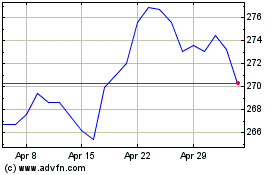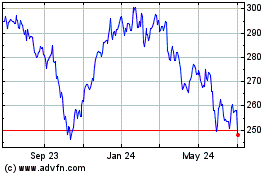McDonald's, Slow to Industry Trends, Cooks Up Changes
January 12 2017 - 1:07PM
Dow Jones News
By Julie Jargon
McDonald's Corp. is in the business of selling food quickly, but
it has been slow to many industry trends, including transferring
ownership of its restaurants to independent operators -- an easy
way to derive stable revenue.
The burger giant, which just announced plans to sell a stake in
its China business and is inviting bids for a stake in its Japan
business, is playing catch-up with other restaurant companies that
began shedding assets years ago.
It wasn't until November 2015, when the company was under
pressure from investors to do something dramatic to boost its
balance sheet such as spin off its real estate holdings, that it
increased the number of restaurants it plans to sell to 4,000 by
the end of 2018 from an earlier target of 3,500. McDonald's has set
a long-term target of being 95% franchise-owned from 83% now.
The model is attractive because it allows a restaurant company
to expand into new markets without having to put up the capital. It
reduces the company's exposure to wage-related pressure and
employee organizing efforts and provides a stable revenue stream
through the royalties it collects from franchisees.
McDonald's is two years into a turnaround plan that was
instituted following its longest sales slump -- and subsequent
share decline -- in a decade that was caused in part by the
migration of customers to rivals serving healthier food. If
McDonald's had handed over ownership of more restaurants to
franchisees sooner, it could have helped solidify its finances and
kept shareholders happy while it worked on improving other aspects
of the business.
Changing restaurant ownership at a company as large as
McDonald's, which has 37,000 restaurants around the world, is hard
to do.
However, sandwich chain Subway, owned by Doctor's Associates
Inc., has nearly 45,000 restaurants around the world and all of
them are franchised.
Meanwhile, direct competitor Burger King, a unit of Restaurant
Brands Inc., began an aggressive push to sell off company-owned
restaurants after Brazilian investment firm 3G Capital Partners LP
bought it in 2010. The mostly franchised model of Canadian doughnut
maker Tim Hortons made that company an attractive target and Burger
King bought it in 2014.
CKE Restaurants Inc., owner of Carl's Jr. and Hardee's, was also
an early adopter of the so-called "asset-light" business model.
Nearly 95% of its more than 3,700 restaurants are now owned by
franchisees. Dunkin Brands Group Inc. has long been nearly 100%
franchise-owned.
Experts say that McDonald's has been slow to change in various
other ways. The company hasn't updated its menu quickly enough to
be in line with changing consumer tastes. For example, it added
Angus burgers and sandwiches made with Sriracha sauce long after
those ingredients were popular.
A McDonald's spokeswoman said that since Steve Easterbrook took
over as chief executive, the company has been focusing on "taking
immediate steps" to help growth and strengthen the bottom line,
which includes restructuring the business and finding strategic
partners.
At times, McDonald's has read consumer demand relatively well.
The chain instituted all-day breakfast in October 2015 after just
six months of testing it. And it was an industry leader on
switching to cage-free eggs.
But there haven't been any new major menu items in a while and
the company has been slow to address problems with its burger
quality.
The company only recently began testing an app that will allow
customers to order and pay for food with their phone, lagging many
others in the industry, and it was late to become involved in
social media -- years behind other major restaurant chains and
retailers.
McDonald's has digital media hubs in Singapore, London, and Oak
Brook, Ill., but as recently as two years ago, McDonald's had no
way to consistently track and respond to what is being said about
it online, a lost opportunity for a brand that gets mentioned on
social media every one to two seconds.
"Their philosophy has been to be more of a follower than a
leader," said David Tarantino, a restaurant analyst at R.W. Baird
& Co. "In the past the organization had a lot of layers of
management and decision making that may have impeded the speed at
which they could have implemented new ideas."
Mr. Easterbrook, who is approaching his second anniversary at
the helm, has been trying to change that.
The company has eliminated many corporate positions as part of a
plan to reduce administrative expenses by $500 million by the end
of 2017, and he has been pushing management to let go of what he
calls "legacy thinking." He has hired an outsider to run the U.S.
business. Mr. Easterbrook told investors in June that "when the
pace of change in the world outside is quicker than the pace of
change within, you start to get left behind."
Write to Julie Jargon at julie.jargon@wsj.com
(END) Dow Jones Newswires
January 12, 2017 12:52 ET (17:52 GMT)
Copyright (c) 2017 Dow Jones & Company, Inc.
McDonalds (NYSE:MCD)
Historical Stock Chart
From Mar 2024 to Apr 2024

McDonalds (NYSE:MCD)
Historical Stock Chart
From Apr 2023 to Apr 2024
